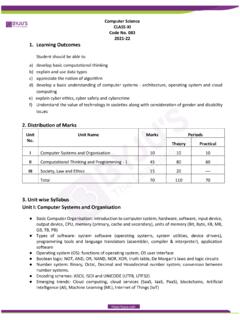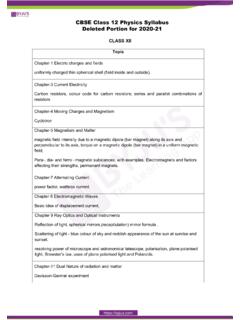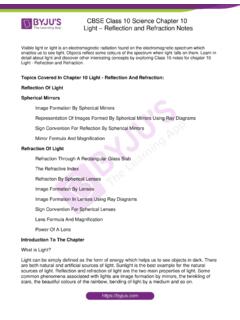Transcription of Salt Analysis - Byju's
1 salt Analysis What is salt Analysis ? salt Analysis (also known as systematic qualitative Analysis or qualitative inorganic Analysis ) involves the identification of the cation and anion of an inorganic salt . This is done by conducting a series of tests in a systematic manner and using the observations to confirm the absence or presence of specific cations and anions. salt Analysis is an integral part of the CBSE class 12 chemistry practical examinations and is a topic that several students struggle with. Therefore, we at BYJU S have channelled our efforts into explaining this topic in a manner that is easy to understand and remember.
2 This article also touches on certain tricks and shortcuts that students can employ to quickly analyze their assigned salts in their chemistry practical examinations. Access in-depth procedures for the tests that must be performed during salt Analysis by visiting the links listed below. Systematic Analysis of Cations Systematic Analysis of Anions In the examination, students will receive an inorganic salt whose chemical composition they must identify. This can be done by individually identifying the cation and the anion of the salt . Step-by-Step Process for salt Analysis Step 1: Obtain the inorganic salt whose cation and anion you must identify.
3 Step 2: Conduct preliminary tests for the anion group-wise until you obtain a positive result. Anions and cations are classified into groups that share the same group reagent and therefore, have similar preliminary tests. Step 3: Once you get a positive result for a preliminary test for an anion, conduct a confirmatory test for that anion. (If you get a positive result, move on to step 4. If you don t, go back to conducting preliminary tests for anions.) Step 4: Conduct preliminary tests for cations group-wise until you obtain a positive result. Step 5: Once a positive result is obtained, conduct a confirmatory test for that cation.
4 Step 6: Now that the cation and the anion are identified, obtain the chemical formula of the salt by balancing the charges of the cation and anion. For example, if your cation is Fe3+ and your anion is Cl-, the chemical formula of the salt will be FeCl3. Note: You can also identify the cation first and then move on to identifying the anion. salt Analysis Answer Format (Sample) A sample answer format for salt Analysis is provided below. Aim: To identify the acidic radical and the basic radical of the given inorganic salt . Apparatus Required: Fill as per requirement. Procedure: (i) Preliminary Test for Anion: Experiment Observation Inference (ii) Confirmatory Test for Anion: Experiment Observation Inference (iii) Preliminary Test for Cation: Experiment Observation Inference (iv) Confirmatory Test for Cation: Experiment Observation Inference Result: The acidic radical is (anion), and the basic radical is (cation).
5 Therefore, the given salt is identified to be ( salt ). Tricks and Shortcuts for salt Analysis Always check the colour of the salt first. Certain cations have coloured salts. If the salt is coloured, you can directly conduct a preliminary test for the cation that forms salts of that colour. The cations that form coloured salts are tabulated below: Colour of the Inorganic salt Cation Blue Cu2+ Deep blue Co2+ (anhydrous salt ) Greenish-blue Cu2+ (hydrated salt ) Green Ni2+ (hydrated salt ) Light green Fe2+ Yellow, brown, or yellowish-brown Fe3+ Pale pink Mn2+ Rose-red Co2+ or mercuric iodide (HgI2) Purple or dark green Cr3+ If the salt is colourless, perform a flame test first (since the presence of 3 different cations can be confirmed by it).
6 An easier way to perform the flame test is to pick up a chunk of the salt with test tube holders, pour a few drops of concentrated HCl on it, and expose it to the flame of a Bunsen burner. If you do not gain any insight into the cation from the flame test (or from visual inspection), proceed with group-wise preliminary tests for cations. Note that some cations do not form salts with certain anions, as listed below. Ba2+, Sr2+, Pb2+, and Ca2+ do not form salts with the sulphate anion (SO42-). Only group 0, group 1, and group 2 cations form salts with the phosphate anion (PO43-). If you identify one of these cations in the salt Analysis , you need not conduct tests for the corresponding anions.
7 Finally, certain salts are very common in salt Analysis examinations. For example, the most common salt containing the bromide ion (Br-) is NH4Br and the most common salt containing the calcium cation (Ca2+) is CaCl2. Also, some salts can be identified by observing their texture and appearance (for example, calcium carbonate has the texture of powdered chalk). Therefore, visiting your chemistry laboratory and physically examining the salts may help you quickly analyze the salt in the practical examination. List of Common Cations (Basic Radicals) for salt Analysis *Note: Multiple Ions belonging to the same group have the same preliminary test but different confirmatory tests.
8 Group Cations Group 0 NH4+ Group 1 Pb2+ Group 2 Cu2+ Group 3 Fe3+, Fe2+, Al3+ Group 4 Co2+, Mn2+, Ni2+, Zn2+ Group 5 Ba2+, Ca2+, Sr2+ Group 6 Mg2+ List of Common Anions (Acidic Radicals) for salt Analysis Group Anions Group 1 CO32-, NO2-, SO32-, S2- Group 2 Cl-, Br-, I-, CH3 COO-, NO3-, C2O42- Group 3 PO43-, SO42- Preliminary Test for Anions In salt Analysis , preliminary tests for anions are conducted group-wise to find the anion of the salt . After getting a positive preliminary test for an anion, a confirmatory test must be conducted to confirm the presence of that anion in the salt . Preliminary Test for Group 1 Anions Experiment: Add a few drops of dilute H2SO4 (sulfuric acid) to a small quantity of the salt in a test tube (If nothing happens, move on to preliminary test for group 2 anions).
9 Anion Positive Result Carbonate (CO32-) Colourless and odourless gas that turns limewater milky Sulphite (SO32-) Colourless, pungent-smelling gas Sulphide (S2-) Colourless gas which smells like rotten eggs Nitrite (NO2-) Light brown gas having a pungent smell Preliminary Test for Group 2 Anions Experiment: Take a small chunk of the salt in a test tube and add a few drops of concentrated H2SO4 (sulfuric acid) to it (If nothing happens, move on to preliminary test for group 2 anions). Anion Positive Result chloride (Cl-) White, pungent-smelling fumes that intensify when a glass rod dipped in ammonium hydroxide is brought to the mouth of the test tube Bromide (Br-) Reddish-brown fumes Iodide (I-) Violet fumes Acetate (CH3 COO-) Pungent fumes that smell like vinegar Nitrate (NO3-) Brown fumes with a pungent smell Oxalate (C2O4-) Bubbly effervescence of a combination of carbon monoxide and carbon dioxide gas Preliminary Test for Group 3 Anions The sulphate and phosphate ions (group 3 anions) do not have any preliminary tests.
10 If no positive preliminary tests are obtained for group 1 and group 2 anions, you can directly jump to confirmatory tests for the sulphate and phosphate anions. Confirmatory Test for Anions *Note: Water extract of the salt can be prepared by dissolving a pinch of the inorganic salt in a few drops of water. Anion Confirmatory Test Positive Observation Carbonate (CO32-) Add magnesium sulphate (MgSO4) to the water extract of the salt Formation of a white precipitate. Sulphite (SO32-) Add aqueous barium chloride (BaCl2) to the water extract Formation of a white precipitate which disappears when diluting hydrochloric acid (HCl) is added.









